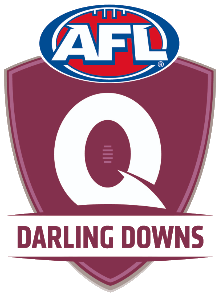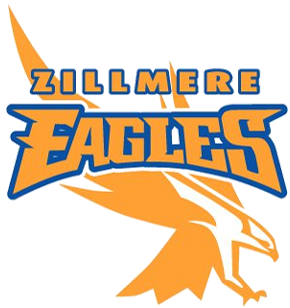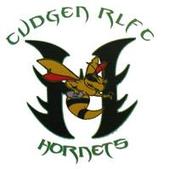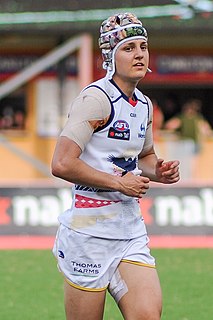The Northern Division of the Queensland Rugby League is responsible for administering the game of rugby league in North Queensland, specifically in the area from Sarina in the south to Cape York and the Torres Strait Islands in the north and west to Mount Isa as well as into the Gulf Communities. There are over 8000 registered players across 36 senior clubs and 39 junior clubs in this division. The Northern Division is responsible for the historic Foley Shield competition that is held each year. Mid West and Mount Isa play in the Toyota Outback Carnival.

AFL Darling Downs is an Australian rules football competition based in the area around the city of Toowoomba west of Brisbane, Queensland. The competition was formed as the Darling Downs Australian Football League in 1971. The senior representative team is known as the Demons and wear guernseys modelled on the Melbourne Demons guernseys.
The East Coast Eagles is an Australian rules football club competing in the Sydney AFL competition based out of the Sydney suburb of Rouse Hill, New South Wales.

Chelmer is a middle suburb in the City of Brisbane, Queensland, Australia, 7 kilometres (4.3 mi) west of the Brisbane CBD on the Brisbane River. Chelmer is zoned as a residential area, and consists of low-density housing. It has many fine Queenslanders, characterised by wooden verandahs, wide stairways and roofing of galvanized iron, but in recent years solid brick homes have been built also. It suffered badly from the 2011 Queensland floods, with many homes submerged by the rising river.

The Queensland Australian Football League (QAFL) is an Australian rules football competition organised by the AFL Queensland, contested by clubs from South East Queensland.

The Morningside Australian Football Club, also known as the Morningside Panthers, is an Australian rules football club based at Jack Esplen Oval in the suburb of Hawthorne in Brisbane. The club consists of Masters, Amateurs, Women's, Junior and Senior football sections. Its senior team competed in the North East Australian Football League (NEAFL) competition in 2011–14 and now is a member club of the Queensland Australian Football League. Its junior sides compete in the AFL Brisbane Juniors (AFLBJ) competition. The club also caters for young girls and boys by running Auskick skills clinics, which are held at the beginning of the season and do not involve competitive games.

Southport Australian Football Club is a Gold Coast based club competing in the NEAFL Australian rules football competition.

Zillmere Eagles Australian Football Club is an Australian rules football club based in the suburb of Zillmere in the northern suburbs of Brisbane. The team plays in the QAFA Division 4.

The Kenmore Australian Football Club, also known as the Kenmore Bears is an Australian rules football club formed as an offshoot of an older junior club which is notable as having produced Australian Football League players Mal Michael and Courtenay Dempsey. Other Australian rules football players Max Hudghton, Jackson Allen, Peter Yagmoor and Rex Liddy spent a significant amount of their junior careers at Kenmore's junior club.

Mount Gravatt Australian Football Club, is a Brisbane based club which competed in the North East Australian Football League competition from 2011–2013 and as of 2014 is a member club of the Queensland Australian Football League., formed in 1964.

Randwick City Saints Australian Football Club is an Australian rules football club based in Sydney, Australia. The club colours are black, white and red. The Saints play in the Platinum Division of the AFL Sydney league and an over 35s side, the Maroubra Sinners. The Maroubra Saints junior AFL club are the local junior feeder club.
Allan Giffard is a former Australian rules footballer who played with the Brisbane Bears in the Victorian Football League (VFL).
Broc McCauley is a former Australian rules footballer, who played for Hawthorn Football Club and Brisbane Lions Football Club in the Australian Football League (AFL).
Wayde Twomey is an Australian rules footballer who played for the Carlton Football Club in the Australian Football League (AFL).

Coomera Australian Football Club is an Australian rules football club based in Gold Coast, Queensland. The team currently competes in the QFA South league.

Dayne Zorko is a professional Australian rules footballer playing for the Brisbane Lions in the Australian Football League (AFL). Zorko is a four-time Merrett–Murray Medallist and was selected in the 2017 All-Australian team. He was also the Lions' leading goalkicker in 2016 and 2017. Zorko has served as Brisbane Lions captain since midway through the 2018 season, after Dayne Beams stepped down from the captaincy.

Australian rules football on the Gold Coast, Queensland can be traced back to the Gold Coast Australian Football League that was established in 1961. The city's interest in the sport has been heavily linked to the Southport Australian Football Club, the Brisbane Football Club and more recently the Gold Coast Football Club. The highest form of the sport played on the Gold Coast is the Australian Football League's team the Gold Coast Football Club, who were admitted into the competition in 2011.

The Cudgen Rugby League Football Club, more commonly known as the Cudgen Hornets, was formed in 1950 and plays at Ned Byrne Field at Kingscliff. It competes in the Gold Coast Rugby League.

Heather Anderson is an Australian Army soldier and Australian rules footballer who played for the Adelaide Football Club in the AFL Women's competition in 2017. She serves as a medic in the 1st Close Health Battalion.














